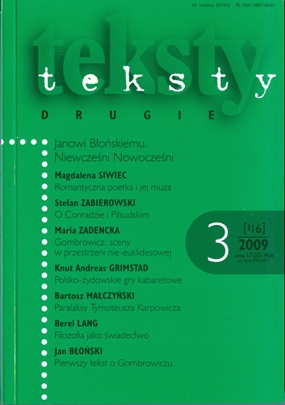Paralaksy Tymoteusza Karpowicza
Tymoteusz Karpowicz’s Parallaxes
Author(s): Bartosz MałczyńskiSubject(s): Literary Texts
Published by: Instytut Badań Literackich Polskiej Akademii Nauk
Keywords: Tymoteusz Karpowicz; Polish Poetry (20th c.); Parallax; Literary Theory.
Summary/Abstract: This article primarily focuses on the category of ‘parallax’ itself, its meaning/significance and how it is entangled in Karpowicz’s obsession of structuring and putting in an order his own and other authors’ texts. I have endeavoured to explain what ‘parallax’ is in the literary sense and how this notion is potentially referable to Tymoteusz Karpowicz’s poetic project as expressed in his Słoje zadrzewne volume. To put it in most general terms, the Karpowicz parallax poem is, primarily, a poem strictly related to its ‘pattern’-text as placed on the left-hand-side of the double-page and usually taken from one of the earlier-date volumes by this poet. But it is, simultaneously, a text that is ‘divergent’ from such a textual ‘norm’ or ‘basis’ in a not-quite-expectable manner; a poem ‘shifted aside’ against its starting point, not overlapping with the latter, not completely adequate. I tried to point out to the crucial points of semantic contact between these two poetic realities and, in parallel, to points of semantic deviations, taking into my consideration a selected exemplary parallactic triad in the form of non-accidental arrangement of three pieces of verse (the sequence being: lampa dowolna and its two parallaxes, i.e.: świętojańskie noce and wykład pindara nad brzegiem mare tenebrarum).
Journal: Teksty Drugie
- Issue Year: 2009
- Issue No: 3
- Page Range: 85-102
- Page Count: 17
- Language: Polish

